Exploring the Helping Process in Healthcare Settings
VerifiedAdded on 2020/05/08
|9
|2294
|279
Essay
AI Summary
The essay provides a comprehensive overview of the fundamental stages inherent in the helping process as applied to healthcare settings. It emphasizes the importance of tailored communication techniques at each stage, showcasing how these strategies facilitate successful patient outcomes. Th...
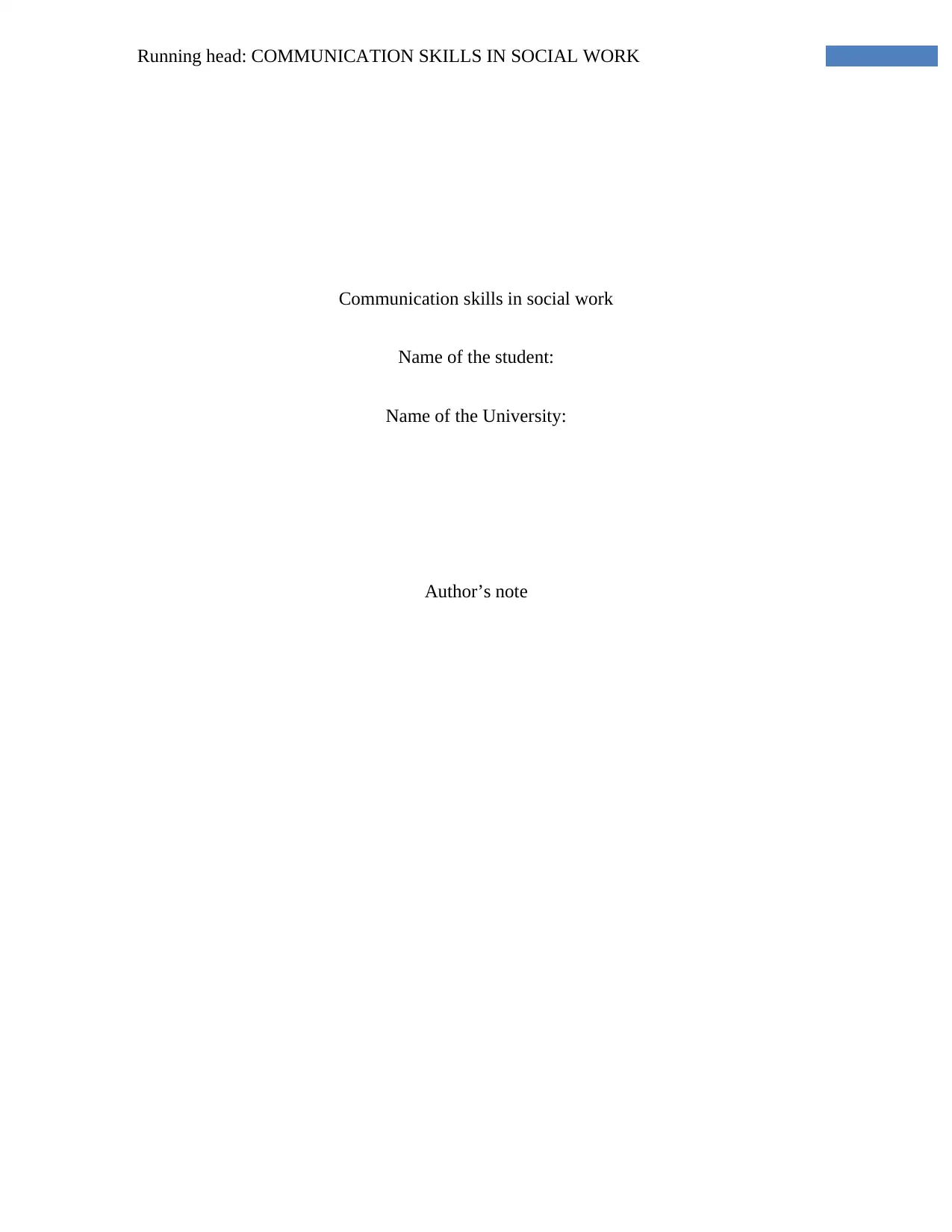
Running head: COMMUNICATION SKILLS IN SOCIAL WORK
Communication skills in social work
Name of the student:
Name of the University:
Author’s note
Communication skills in social work
Name of the student:
Name of the University:
Author’s note
Paraphrase This Document
Need a fresh take? Get an instant paraphrase of this document with our AI Paraphraser
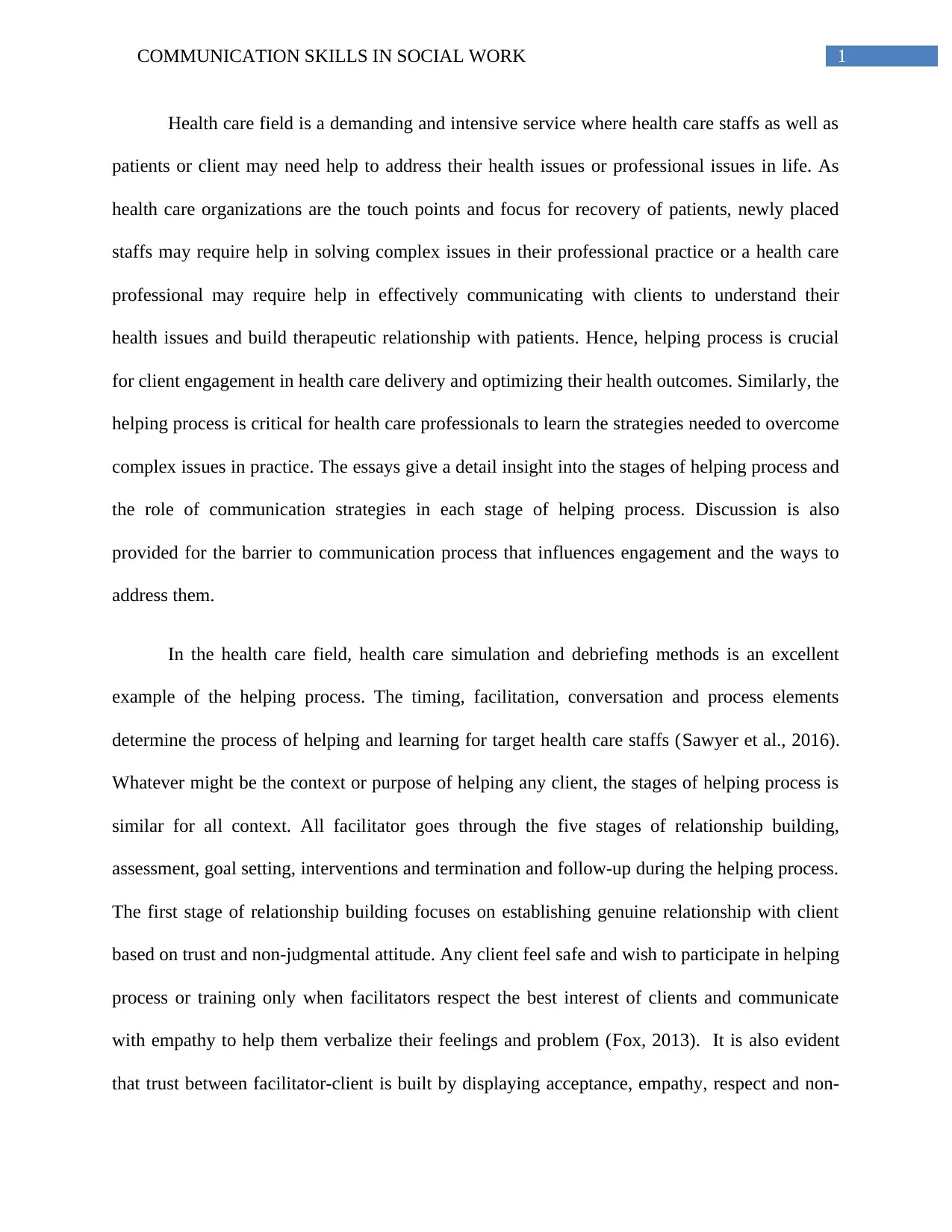
1COMMUNICATION SKILLS IN SOCIAL WORK
Health care field is a demanding and intensive service where health care staffs as well as
patients or client may need help to address their health issues or professional issues in life. As
health care organizations are the touch points and focus for recovery of patients, newly placed
staffs may require help in solving complex issues in their professional practice or a health care
professional may require help in effectively communicating with clients to understand their
health issues and build therapeutic relationship with patients. Hence, helping process is crucial
for client engagement in health care delivery and optimizing their health outcomes. Similarly, the
helping process is critical for health care professionals to learn the strategies needed to overcome
complex issues in practice. The essays give a detail insight into the stages of helping process and
the role of communication strategies in each stage of helping process. Discussion is also
provided for the barrier to communication process that influences engagement and the ways to
address them.
In the health care field, health care simulation and debriefing methods is an excellent
example of the helping process. The timing, facilitation, conversation and process elements
determine the process of helping and learning for target health care staffs (Sawyer et al., 2016).
Whatever might be the context or purpose of helping any client, the stages of helping process is
similar for all context. All facilitator goes through the five stages of relationship building,
assessment, goal setting, interventions and termination and follow-up during the helping process.
The first stage of relationship building focuses on establishing genuine relationship with client
based on trust and non-judgmental attitude. Any client feel safe and wish to participate in helping
process or training only when facilitators respect the best interest of clients and communicate
with empathy to help them verbalize their feelings and problem (Fox, 2013). It is also evident
that trust between facilitator-client is built by displaying acceptance, empathy, respect and non-
Health care field is a demanding and intensive service where health care staffs as well as
patients or client may need help to address their health issues or professional issues in life. As
health care organizations are the touch points and focus for recovery of patients, newly placed
staffs may require help in solving complex issues in their professional practice or a health care
professional may require help in effectively communicating with clients to understand their
health issues and build therapeutic relationship with patients. Hence, helping process is crucial
for client engagement in health care delivery and optimizing their health outcomes. Similarly, the
helping process is critical for health care professionals to learn the strategies needed to overcome
complex issues in practice. The essays give a detail insight into the stages of helping process and
the role of communication strategies in each stage of helping process. Discussion is also
provided for the barrier to communication process that influences engagement and the ways to
address them.
In the health care field, health care simulation and debriefing methods is an excellent
example of the helping process. The timing, facilitation, conversation and process elements
determine the process of helping and learning for target health care staffs (Sawyer et al., 2016).
Whatever might be the context or purpose of helping any client, the stages of helping process is
similar for all context. All facilitator goes through the five stages of relationship building,
assessment, goal setting, interventions and termination and follow-up during the helping process.
The first stage of relationship building focuses on establishing genuine relationship with client
based on trust and non-judgmental attitude. Any client feel safe and wish to participate in helping
process or training only when facilitators respect the best interest of clients and communicate
with empathy to help them verbalize their feelings and problem (Fox, 2013). It is also evident
that trust between facilitator-client is built by displaying acceptance, empathy, respect and non-
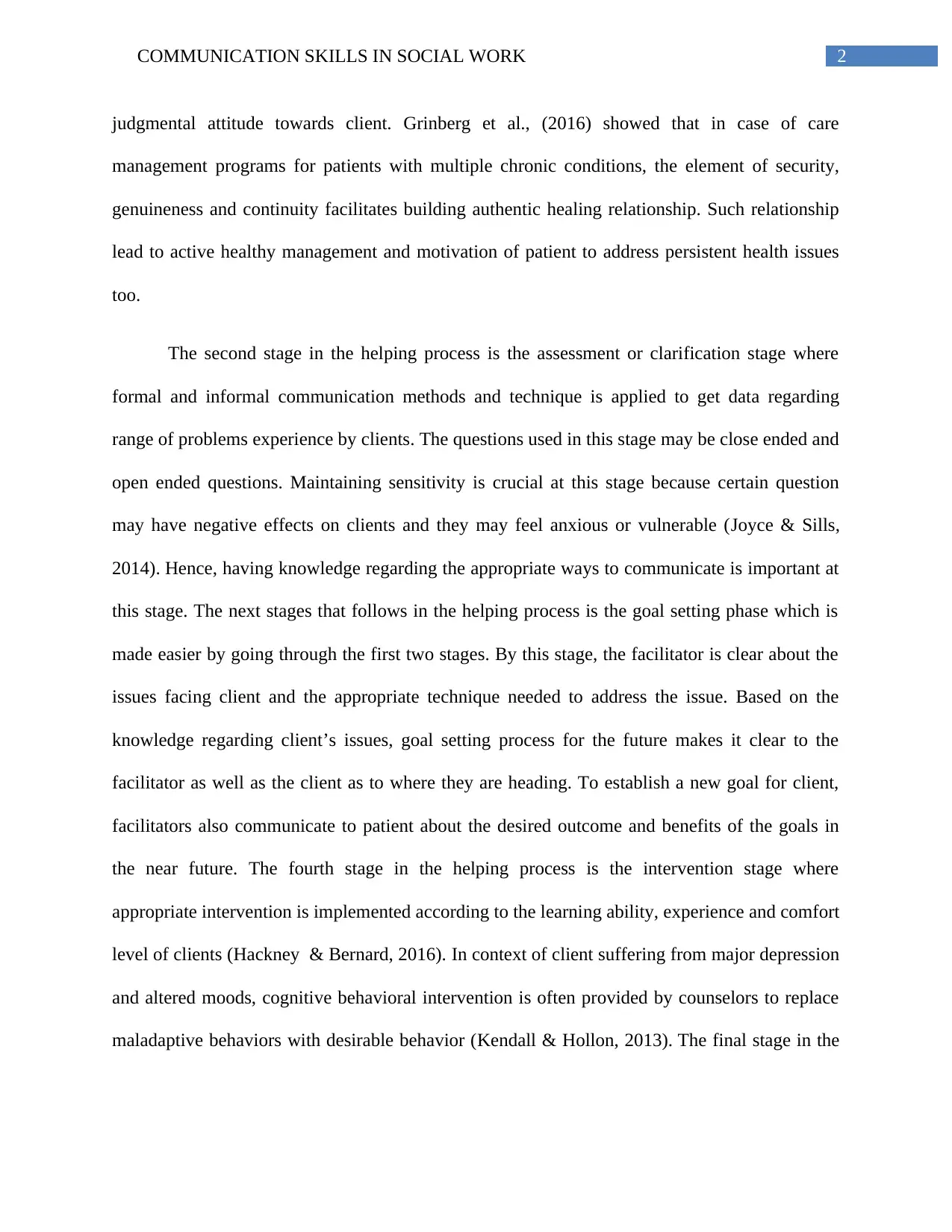
2COMMUNICATION SKILLS IN SOCIAL WORK
judgmental attitude towards client. Grinberg et al., (2016) showed that in case of care
management programs for patients with multiple chronic conditions, the element of security,
genuineness and continuity facilitates building authentic healing relationship. Such relationship
lead to active healthy management and motivation of patient to address persistent health issues
too.
The second stage in the helping process is the assessment or clarification stage where
formal and informal communication methods and technique is applied to get data regarding
range of problems experience by clients. The questions used in this stage may be close ended and
open ended questions. Maintaining sensitivity is crucial at this stage because certain question
may have negative effects on clients and they may feel anxious or vulnerable (Joyce & Sills,
2014). Hence, having knowledge regarding the appropriate ways to communicate is important at
this stage. The next stages that follows in the helping process is the goal setting phase which is
made easier by going through the first two stages. By this stage, the facilitator is clear about the
issues facing client and the appropriate technique needed to address the issue. Based on the
knowledge regarding client’s issues, goal setting process for the future makes it clear to the
facilitator as well as the client as to where they are heading. To establish a new goal for client,
facilitators also communicate to patient about the desired outcome and benefits of the goals in
the near future. The fourth stage in the helping process is the intervention stage where
appropriate intervention is implemented according to the learning ability, experience and comfort
level of clients (Hackney & Bernard, 2016). In context of client suffering from major depression
and altered moods, cognitive behavioral intervention is often provided by counselors to replace
maladaptive behaviors with desirable behavior (Kendall & Hollon, 2013). The final stage in the
judgmental attitude towards client. Grinberg et al., (2016) showed that in case of care
management programs for patients with multiple chronic conditions, the element of security,
genuineness and continuity facilitates building authentic healing relationship. Such relationship
lead to active healthy management and motivation of patient to address persistent health issues
too.
The second stage in the helping process is the assessment or clarification stage where
formal and informal communication methods and technique is applied to get data regarding
range of problems experience by clients. The questions used in this stage may be close ended and
open ended questions. Maintaining sensitivity is crucial at this stage because certain question
may have negative effects on clients and they may feel anxious or vulnerable (Joyce & Sills,
2014). Hence, having knowledge regarding the appropriate ways to communicate is important at
this stage. The next stages that follows in the helping process is the goal setting phase which is
made easier by going through the first two stages. By this stage, the facilitator is clear about the
issues facing client and the appropriate technique needed to address the issue. Based on the
knowledge regarding client’s issues, goal setting process for the future makes it clear to the
facilitator as well as the client as to where they are heading. To establish a new goal for client,
facilitators also communicate to patient about the desired outcome and benefits of the goals in
the near future. The fourth stage in the helping process is the intervention stage where
appropriate intervention is implemented according to the learning ability, experience and comfort
level of clients (Hackney & Bernard, 2016). In context of client suffering from major depression
and altered moods, cognitive behavioral intervention is often provided by counselors to replace
maladaptive behaviors with desirable behavior (Kendall & Hollon, 2013). The final stage in the
You're viewing a preview
Unlock full access by subscribing today!
Enjoy unlimited downloads | Full document access |
Advanced AI study tools
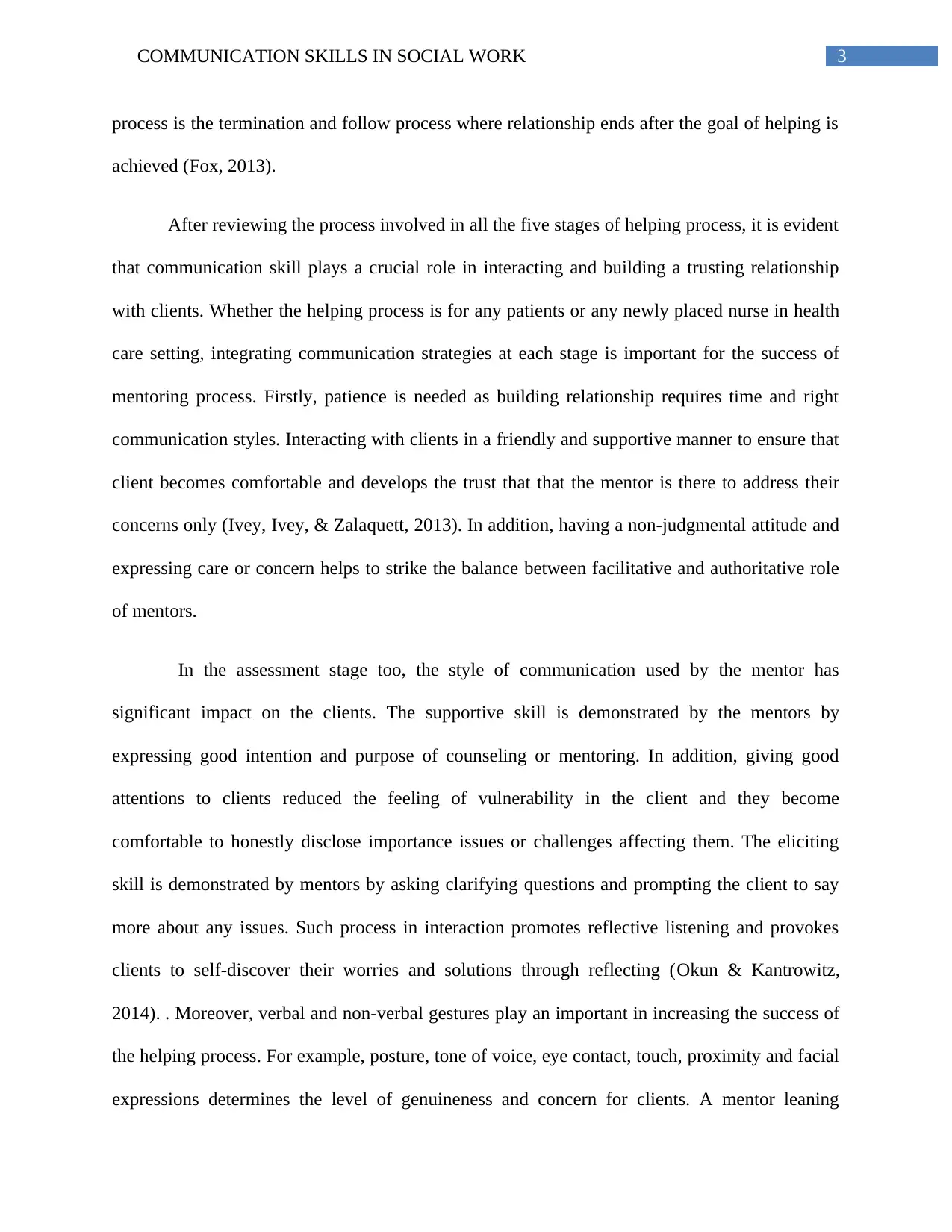
3COMMUNICATION SKILLS IN SOCIAL WORK
process is the termination and follow process where relationship ends after the goal of helping is
achieved (Fox, 2013).
After reviewing the process involved in all the five stages of helping process, it is evident
that communication skill plays a crucial role in interacting and building a trusting relationship
with clients. Whether the helping process is for any patients or any newly placed nurse in health
care setting, integrating communication strategies at each stage is important for the success of
mentoring process. Firstly, patience is needed as building relationship requires time and right
communication styles. Interacting with clients in a friendly and supportive manner to ensure that
client becomes comfortable and develops the trust that that the mentor is there to address their
concerns only (Ivey, Ivey, & Zalaquett, 2013). In addition, having a non-judgmental attitude and
expressing care or concern helps to strike the balance between facilitative and authoritative role
of mentors.
In the assessment stage too, the style of communication used by the mentor has
significant impact on the clients. The supportive skill is demonstrated by the mentors by
expressing good intention and purpose of counseling or mentoring. In addition, giving good
attentions to clients reduced the feeling of vulnerability in the client and they become
comfortable to honestly disclose importance issues or challenges affecting them. The eliciting
skill is demonstrated by mentors by asking clarifying questions and prompting the client to say
more about any issues. Such process in interaction promotes reflective listening and provokes
clients to self-discover their worries and solutions through reflecting (Okun & Kantrowitz,
2014). . Moreover, verbal and non-verbal gestures play an important in increasing the success of
the helping process. For example, posture, tone of voice, eye contact, touch, proximity and facial
expressions determines the level of genuineness and concern for clients. A mentor leaning
process is the termination and follow process where relationship ends after the goal of helping is
achieved (Fox, 2013).
After reviewing the process involved in all the five stages of helping process, it is evident
that communication skill plays a crucial role in interacting and building a trusting relationship
with clients. Whether the helping process is for any patients or any newly placed nurse in health
care setting, integrating communication strategies at each stage is important for the success of
mentoring process. Firstly, patience is needed as building relationship requires time and right
communication styles. Interacting with clients in a friendly and supportive manner to ensure that
client becomes comfortable and develops the trust that that the mentor is there to address their
concerns only (Ivey, Ivey, & Zalaquett, 2013). In addition, having a non-judgmental attitude and
expressing care or concern helps to strike the balance between facilitative and authoritative role
of mentors.
In the assessment stage too, the style of communication used by the mentor has
significant impact on the clients. The supportive skill is demonstrated by the mentors by
expressing good intention and purpose of counseling or mentoring. In addition, giving good
attentions to clients reduced the feeling of vulnerability in the client and they become
comfortable to honestly disclose importance issues or challenges affecting them. The eliciting
skill is demonstrated by mentors by asking clarifying questions and prompting the client to say
more about any issues. Such process in interaction promotes reflective listening and provokes
clients to self-discover their worries and solutions through reflecting (Okun & Kantrowitz,
2014). . Moreover, verbal and non-verbal gestures play an important in increasing the success of
the helping process. For example, posture, tone of voice, eye contact, touch, proximity and facial
expressions determines the level of genuineness and concern for clients. A mentor leaning
Paraphrase This Document
Need a fresh take? Get an instant paraphrase of this document with our AI Paraphraser
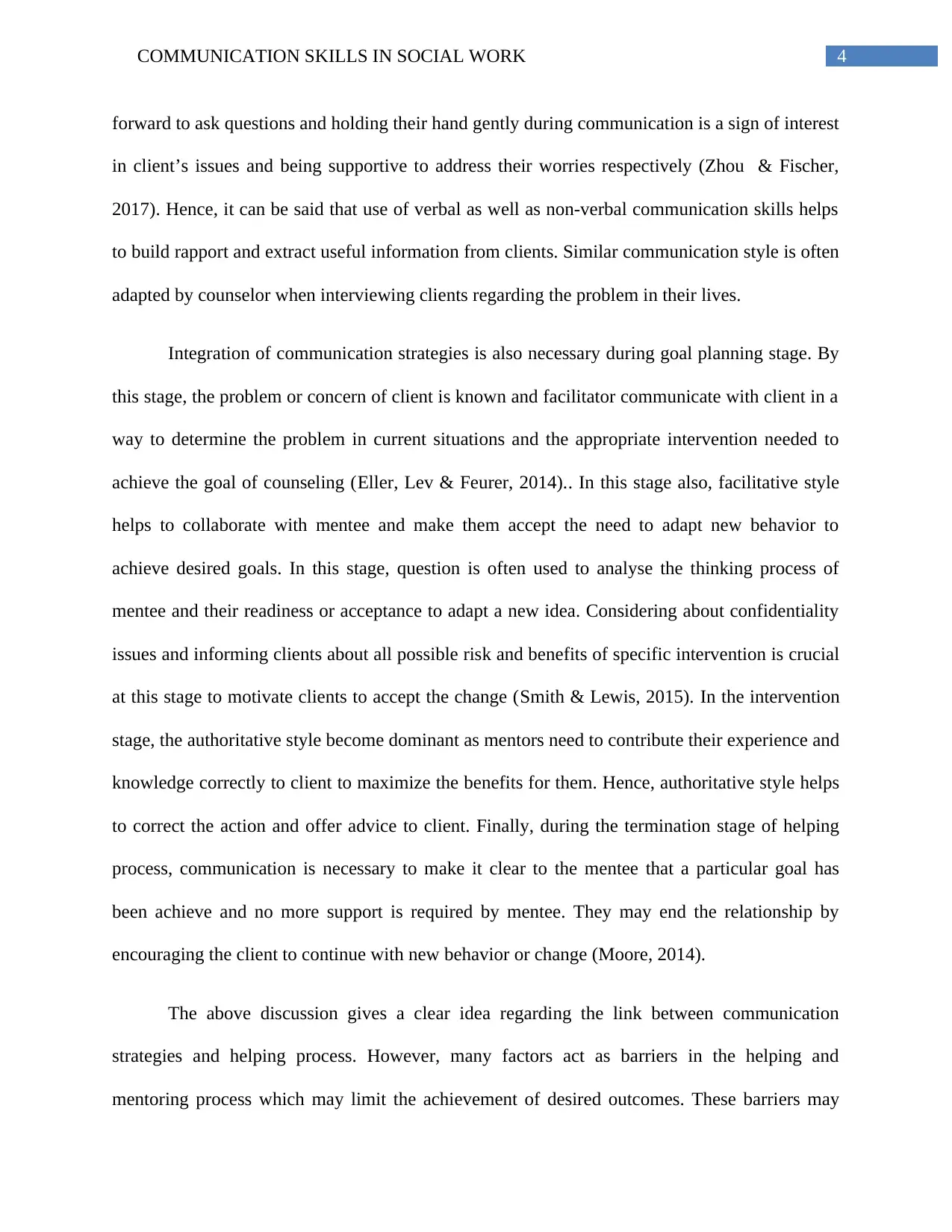
4COMMUNICATION SKILLS IN SOCIAL WORK
forward to ask questions and holding their hand gently during communication is a sign of interest
in client’s issues and being supportive to address their worries respectively (Zhou & Fischer,
2017). Hence, it can be said that use of verbal as well as non-verbal communication skills helps
to build rapport and extract useful information from clients. Similar communication style is often
adapted by counselor when interviewing clients regarding the problem in their lives.
Integration of communication strategies is also necessary during goal planning stage. By
this stage, the problem or concern of client is known and facilitator communicate with client in a
way to determine the problem in current situations and the appropriate intervention needed to
achieve the goal of counseling (Eller, Lev & Feurer, 2014).. In this stage also, facilitative style
helps to collaborate with mentee and make them accept the need to adapt new behavior to
achieve desired goals. In this stage, question is often used to analyse the thinking process of
mentee and their readiness or acceptance to adapt a new idea. Considering about confidentiality
issues and informing clients about all possible risk and benefits of specific intervention is crucial
at this stage to motivate clients to accept the change (Smith & Lewis, 2015). In the intervention
stage, the authoritative style become dominant as mentors need to contribute their experience and
knowledge correctly to client to maximize the benefits for them. Hence, authoritative style helps
to correct the action and offer advice to client. Finally, during the termination stage of helping
process, communication is necessary to make it clear to the mentee that a particular goal has
been achieve and no more support is required by mentee. They may end the relationship by
encouraging the client to continue with new behavior or change (Moore, 2014).
The above discussion gives a clear idea regarding the link between communication
strategies and helping process. However, many factors act as barriers in the helping and
mentoring process which may limit the achievement of desired outcomes. These barriers may
forward to ask questions and holding their hand gently during communication is a sign of interest
in client’s issues and being supportive to address their worries respectively (Zhou & Fischer,
2017). Hence, it can be said that use of verbal as well as non-verbal communication skills helps
to build rapport and extract useful information from clients. Similar communication style is often
adapted by counselor when interviewing clients regarding the problem in their lives.
Integration of communication strategies is also necessary during goal planning stage. By
this stage, the problem or concern of client is known and facilitator communicate with client in a
way to determine the problem in current situations and the appropriate intervention needed to
achieve the goal of counseling (Eller, Lev & Feurer, 2014).. In this stage also, facilitative style
helps to collaborate with mentee and make them accept the need to adapt new behavior to
achieve desired goals. In this stage, question is often used to analyse the thinking process of
mentee and their readiness or acceptance to adapt a new idea. Considering about confidentiality
issues and informing clients about all possible risk and benefits of specific intervention is crucial
at this stage to motivate clients to accept the change (Smith & Lewis, 2015). In the intervention
stage, the authoritative style become dominant as mentors need to contribute their experience and
knowledge correctly to client to maximize the benefits for them. Hence, authoritative style helps
to correct the action and offer advice to client. Finally, during the termination stage of helping
process, communication is necessary to make it clear to the mentee that a particular goal has
been achieve and no more support is required by mentee. They may end the relationship by
encouraging the client to continue with new behavior or change (Moore, 2014).
The above discussion gives a clear idea regarding the link between communication
strategies and helping process. However, many factors act as barriers in the helping and
mentoring process which may limit the achievement of desired outcomes. These barriers may
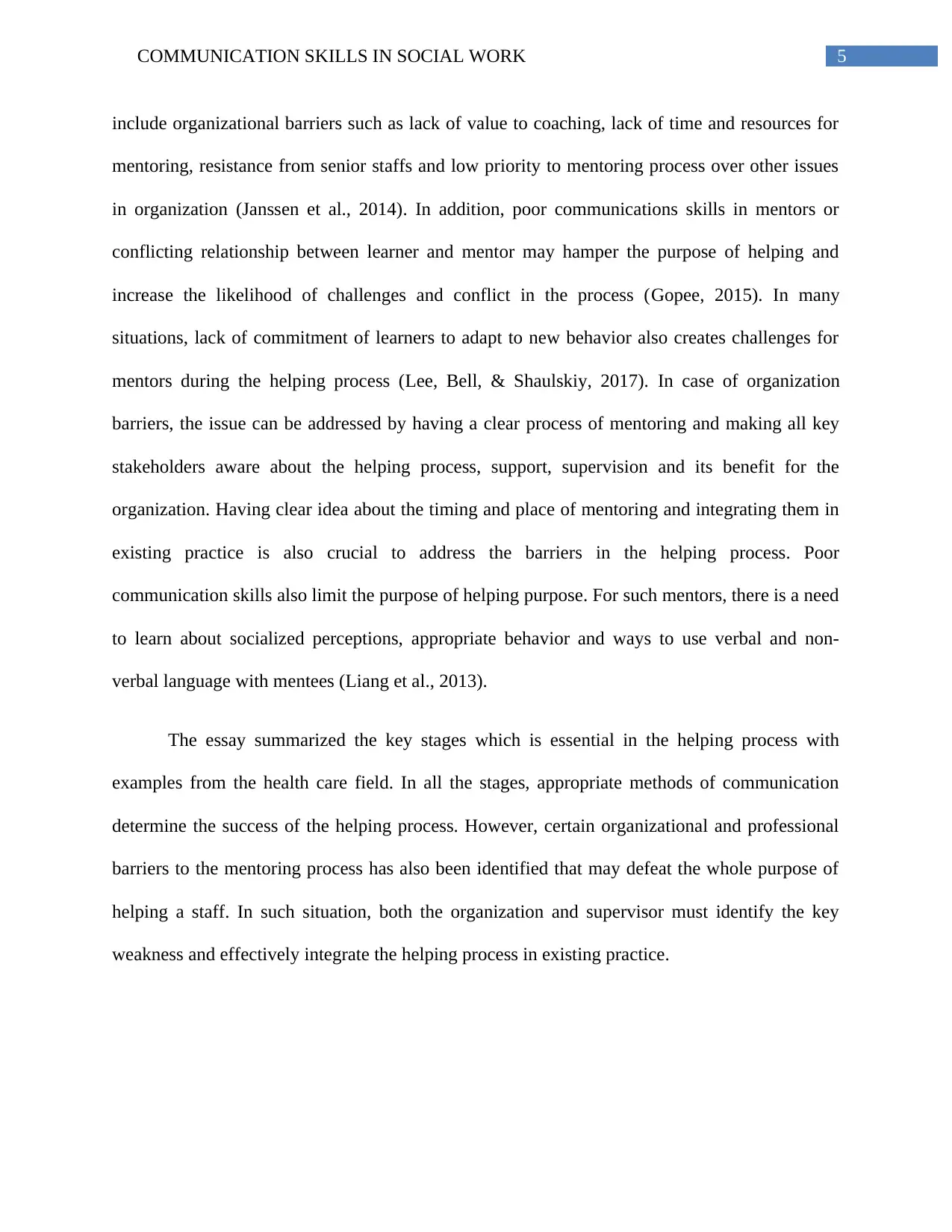
5COMMUNICATION SKILLS IN SOCIAL WORK
include organizational barriers such as lack of value to coaching, lack of time and resources for
mentoring, resistance from senior staffs and low priority to mentoring process over other issues
in organization (Janssen et al., 2014). In addition, poor communications skills in mentors or
conflicting relationship between learner and mentor may hamper the purpose of helping and
increase the likelihood of challenges and conflict in the process (Gopee, 2015). In many
situations, lack of commitment of learners to adapt to new behavior also creates challenges for
mentors during the helping process (Lee, Bell, & Shaulskiy, 2017). In case of organization
barriers, the issue can be addressed by having a clear process of mentoring and making all key
stakeholders aware about the helping process, support, supervision and its benefit for the
organization. Having clear idea about the timing and place of mentoring and integrating them in
existing practice is also crucial to address the barriers in the helping process. Poor
communication skills also limit the purpose of helping purpose. For such mentors, there is a need
to learn about socialized perceptions, appropriate behavior and ways to use verbal and non-
verbal language with mentees (Liang et al., 2013).
The essay summarized the key stages which is essential in the helping process with
examples from the health care field. In all the stages, appropriate methods of communication
determine the success of the helping process. However, certain organizational and professional
barriers to the mentoring process has also been identified that may defeat the whole purpose of
helping a staff. In such situation, both the organization and supervisor must identify the key
weakness and effectively integrate the helping process in existing practice.
include organizational barriers such as lack of value to coaching, lack of time and resources for
mentoring, resistance from senior staffs and low priority to mentoring process over other issues
in organization (Janssen et al., 2014). In addition, poor communications skills in mentors or
conflicting relationship between learner and mentor may hamper the purpose of helping and
increase the likelihood of challenges and conflict in the process (Gopee, 2015). In many
situations, lack of commitment of learners to adapt to new behavior also creates challenges for
mentors during the helping process (Lee, Bell, & Shaulskiy, 2017). In case of organization
barriers, the issue can be addressed by having a clear process of mentoring and making all key
stakeholders aware about the helping process, support, supervision and its benefit for the
organization. Having clear idea about the timing and place of mentoring and integrating them in
existing practice is also crucial to address the barriers in the helping process. Poor
communication skills also limit the purpose of helping purpose. For such mentors, there is a need
to learn about socialized perceptions, appropriate behavior and ways to use verbal and non-
verbal language with mentees (Liang et al., 2013).
The essay summarized the key stages which is essential in the helping process with
examples from the health care field. In all the stages, appropriate methods of communication
determine the success of the helping process. However, certain organizational and professional
barriers to the mentoring process has also been identified that may defeat the whole purpose of
helping a staff. In such situation, both the organization and supervisor must identify the key
weakness and effectively integrate the helping process in existing practice.
You're viewing a preview
Unlock full access by subscribing today!
Enjoy unlimited downloads | Full document access |
Advanced AI study tools
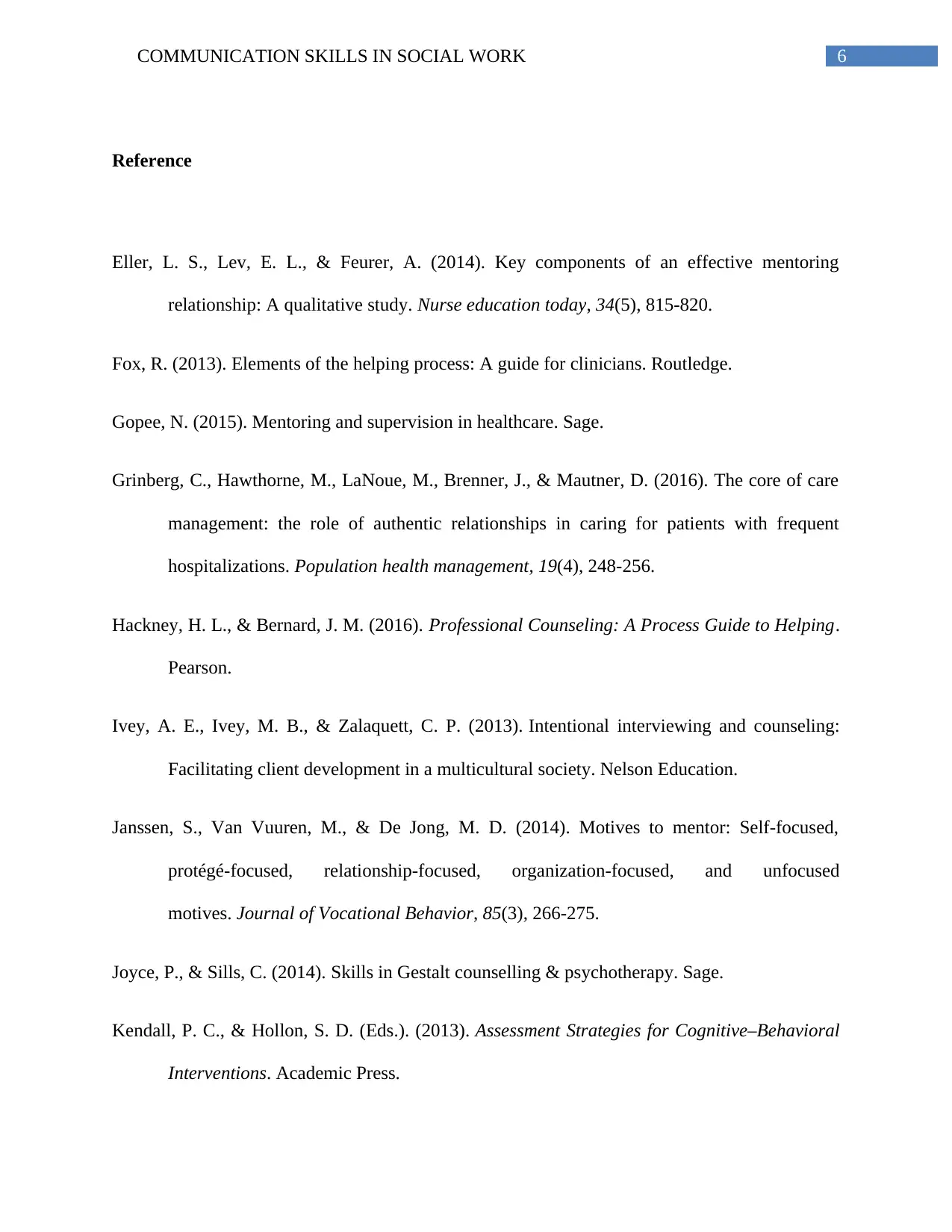
6COMMUNICATION SKILLS IN SOCIAL WORK
Reference
Eller, L. S., Lev, E. L., & Feurer, A. (2014). Key components of an effective mentoring
relationship: A qualitative study. Nurse education today, 34(5), 815-820.
Fox, R. (2013). Elements of the helping process: A guide for clinicians. Routledge.
Gopee, N. (2015). Mentoring and supervision in healthcare. Sage.
Grinberg, C., Hawthorne, M., LaNoue, M., Brenner, J., & Mautner, D. (2016). The core of care
management: the role of authentic relationships in caring for patients with frequent
hospitalizations. Population health management, 19(4), 248-256.
Hackney, H. L., & Bernard, J. M. (2016). Professional Counseling: A Process Guide to Helping.
Pearson.
Ivey, A. E., Ivey, M. B., & Zalaquett, C. P. (2013). Intentional interviewing and counseling:
Facilitating client development in a multicultural society. Nelson Education.
Janssen, S., Van Vuuren, M., & De Jong, M. D. (2014). Motives to mentor: Self-focused,
protégé-focused, relationship-focused, organization-focused, and unfocused
motives. Journal of Vocational Behavior, 85(3), 266-275.
Joyce, P., & Sills, C. (2014). Skills in Gestalt counselling & psychotherapy. Sage.
Kendall, P. C., & Hollon, S. D. (Eds.). (2013). Assessment Strategies for Cognitive–Behavioral
Interventions. Academic Press.
Reference
Eller, L. S., Lev, E. L., & Feurer, A. (2014). Key components of an effective mentoring
relationship: A qualitative study. Nurse education today, 34(5), 815-820.
Fox, R. (2013). Elements of the helping process: A guide for clinicians. Routledge.
Gopee, N. (2015). Mentoring and supervision in healthcare. Sage.
Grinberg, C., Hawthorne, M., LaNoue, M., Brenner, J., & Mautner, D. (2016). The core of care
management: the role of authentic relationships in caring for patients with frequent
hospitalizations. Population health management, 19(4), 248-256.
Hackney, H. L., & Bernard, J. M. (2016). Professional Counseling: A Process Guide to Helping.
Pearson.
Ivey, A. E., Ivey, M. B., & Zalaquett, C. P. (2013). Intentional interviewing and counseling:
Facilitating client development in a multicultural society. Nelson Education.
Janssen, S., Van Vuuren, M., & De Jong, M. D. (2014). Motives to mentor: Self-focused,
protégé-focused, relationship-focused, organization-focused, and unfocused
motives. Journal of Vocational Behavior, 85(3), 266-275.
Joyce, P., & Sills, C. (2014). Skills in Gestalt counselling & psychotherapy. Sage.
Kendall, P. C., & Hollon, S. D. (Eds.). (2013). Assessment Strategies for Cognitive–Behavioral
Interventions. Academic Press.
Paraphrase This Document
Need a fresh take? Get an instant paraphrase of this document with our AI Paraphraser
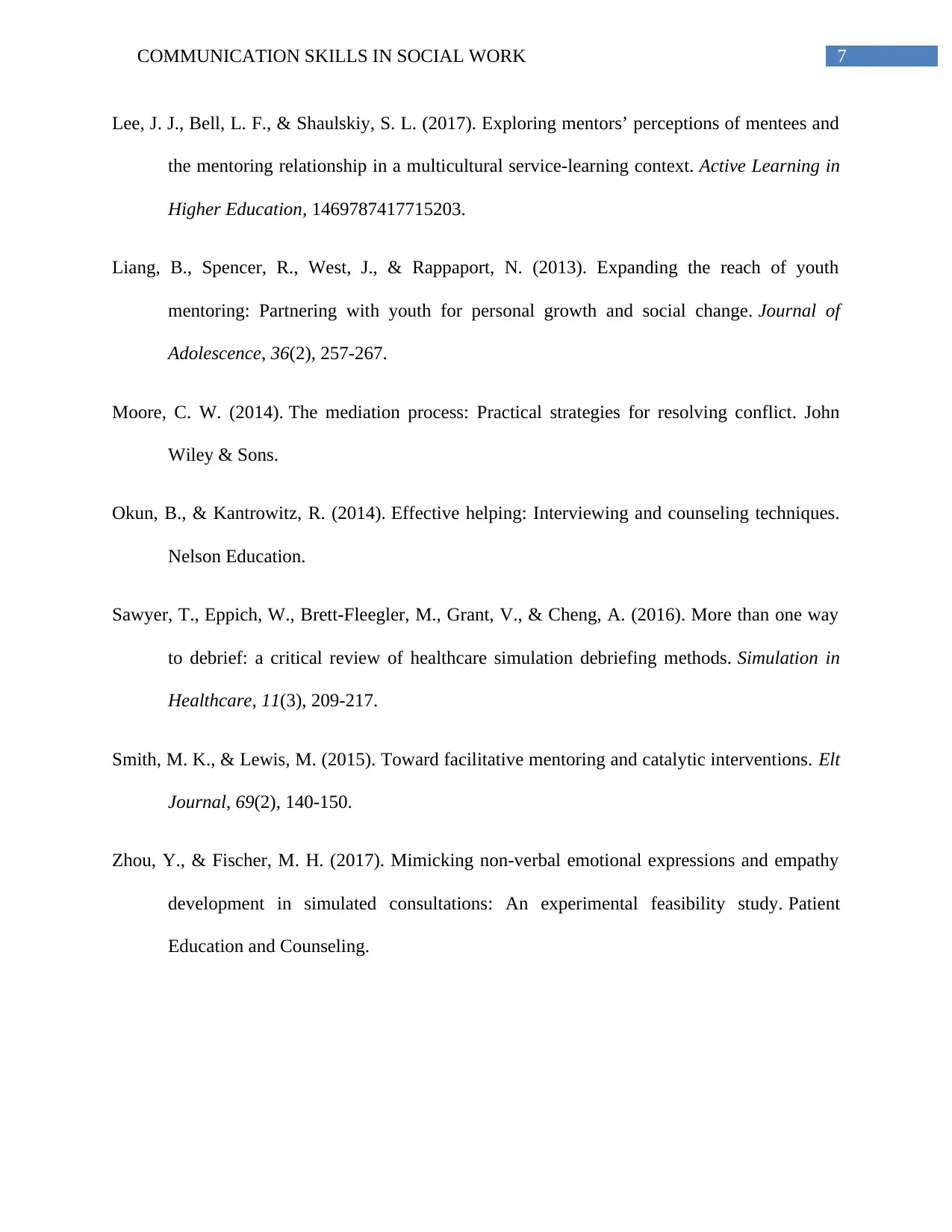
7COMMUNICATION SKILLS IN SOCIAL WORK
Lee, J. J., Bell, L. F., & Shaulskiy, S. L. (2017). Exploring mentors’ perceptions of mentees and
the mentoring relationship in a multicultural service-learning context. Active Learning in
Higher Education, 1469787417715203.
Liang, B., Spencer, R., West, J., & Rappaport, N. (2013). Expanding the reach of youth
mentoring: Partnering with youth for personal growth and social change. Journal of
Adolescence, 36(2), 257-267.
Moore, C. W. (2014). The mediation process: Practical strategies for resolving conflict. John
Wiley & Sons.
Okun, B., & Kantrowitz, R. (2014). Effective helping: Interviewing and counseling techniques.
Nelson Education.
Sawyer, T., Eppich, W., Brett-Fleegler, M., Grant, V., & Cheng, A. (2016). More than one way
to debrief: a critical review of healthcare simulation debriefing methods. Simulation in
Healthcare, 11(3), 209-217.
Smith, M. K., & Lewis, M. (2015). Toward facilitative mentoring and catalytic interventions. Elt
Journal, 69(2), 140-150.
Zhou, Y., & Fischer, M. H. (2017). Mimicking non-verbal emotional expressions and empathy
development in simulated consultations: An experimental feasibility study. Patient
Education and Counseling.
Lee, J. J., Bell, L. F., & Shaulskiy, S. L. (2017). Exploring mentors’ perceptions of mentees and
the mentoring relationship in a multicultural service-learning context. Active Learning in
Higher Education, 1469787417715203.
Liang, B., Spencer, R., West, J., & Rappaport, N. (2013). Expanding the reach of youth
mentoring: Partnering with youth for personal growth and social change. Journal of
Adolescence, 36(2), 257-267.
Moore, C. W. (2014). The mediation process: Practical strategies for resolving conflict. John
Wiley & Sons.
Okun, B., & Kantrowitz, R. (2014). Effective helping: Interviewing and counseling techniques.
Nelson Education.
Sawyer, T., Eppich, W., Brett-Fleegler, M., Grant, V., & Cheng, A. (2016). More than one way
to debrief: a critical review of healthcare simulation debriefing methods. Simulation in
Healthcare, 11(3), 209-217.
Smith, M. K., & Lewis, M. (2015). Toward facilitative mentoring and catalytic interventions. Elt
Journal, 69(2), 140-150.
Zhou, Y., & Fischer, M. H. (2017). Mimicking non-verbal emotional expressions and empathy
development in simulated consultations: An experimental feasibility study. Patient
Education and Counseling.

8COMMUNICATION SKILLS IN SOCIAL WORK
You're viewing a preview
Unlock full access by subscribing today!
Enjoy unlimited downloads | Full document access |
Advanced AI study tools
1 out of 9
Related Documents
Your All-in-One AI-Powered Toolkit for Academic Success.
+13062052269
info@desklib.com
Available 24*7 on WhatsApp / Email
![[object Object]](/_next/static/media/star-bottom.7253800d.svg)
Unlock your academic potential
© 2024 | Zucol Services PVT LTD | All rights reserved.





